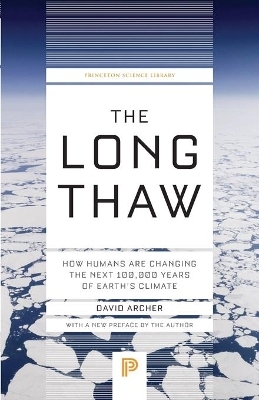
The Long Thaw
Princeton University Press (Verlag)
978-0-691-16906-4 (ISBN)
The human impact on Earth's climate is often treated as a hundred-year issue lasting as far into the future as 2100, the year in which most climate projections cease. In The Long Thaw, David Archer, one of the world's leading climatologists, reveals the hard truth that these changes in climate will be "locked in," essentially forever. If you think that global warming means slightly hotter weather and a modest rise in sea levels that will persist only so long as fossil fuels hold out (or until we decide to stop burning them), think again. In The Long Thaw, David Archer predicts that if we continue to emit carbon dioxide we may eventually cancel the next ice age and raise the oceans by 50 meters. A human-driven, planet-wide thaw has already begun, and will continue to impact Earth's climate and sea level for hundreds of thousands of years. The great ice sheets in Antarctica and Greenland may take more than a century to melt, and the overall change in sea level will be one hundred times what is forecast for 2100.
By comparing the global warming projection for the next century to natural climate changes of the distant past, and then looking into the future far beyond the usual scientific and political horizon of the year 2100, Archer reveals the hard truths of the long-term climate forecast. Archer shows how just a few centuries of fossil-fuel use will cause not only a climate storm that will last a few hundred years, but dramatic climate changes that will last thousands. Carbon dioxide emitted today will be a problem for millennia. For the first time, humans have become major players in shaping the long-term climate. In fact, a planetwide thaw driven by humans has already begun. But despite the seriousness of the situation, Archer argues that it is still not too late to avert dangerous climate change--if humans can find a way to cooperate as never before. Revealing why carbon dioxide may be an even worse gamble in the long run than in the short, this compelling and critically important book brings the best long-term climate science to a general audience for the first time.
With a new preface that discusses recent advances in climate science, and the impact on global warming and climate change, The Long Thaw shows that it is still not too late to avert dangerous climate change--if we can find a way to cooperate as never before.
David Archer is professor of geophysical sciences at the University of Chicago. He is the author of many books, including The Global Carbon Cycle (Princeton).
Preface to the Princeton Science Library Edition xi Acknowledgments xiiii Prologue. Global Warming in Geologic Time. 1 An overview of the thrust of the book: human-induced climate change in the context of geologic time, in the past and in the future. SECTION I: THE PRESENT Chapter 1. The Greenhouse Effect. 15 Fourier and greenhouse theory Early CO2 measurements Arrhenius and the forecast. Climate science since then. Chapter 2: We've Seen It with Our Own Eyes. 30 Testing the forecast. Impacts already. Chapter 3: Forecast of the Century. 45 A century-timescale climate spike. Temperature, rainfall, sea level, and storms. SECTION II: THE PAST Chapter 4: Millennial Climate Cycles. 57 Abrupt climate transitions, and climate cycles on millennial timescales. The Little Ice Age and the Medieval Optimum climates. Chapter 5: Glacial Climate Cycles. 69 History of their discovery. Ice flows and melts in quirky ways. Orbital forcing and CO2 forcing. 69 Chapter 6: Geologic Climate Cycles. 78 Our ice age is unusual. The Earth is breathing. Chapter 7: The Present in the Bosom of the Past. 91 Climate change so far and in the coming century, compared with deglaciation, abrupt climate change, the Eocene hothouse, the Paleocene/Eocene thermal maximum event, and the K/T boundary. SECTION III: THE FUTURE Chapter 8: The Fate of Fossil Fuel CO2. 101 Reservoirs of carbon, breathing. New carbon from fossil fuels equilibrates with the ocean and the land. Chapter 9: Acidifying the Ocean. 114 CO2 is an acid. CaCO3 is a base. Neutralization takes millennia. CO2 remains higher than natural for hundreds of millennia. Chapter 10: Carbon Cycle Feedbacks. 125 The short-term prognosis. The long-term prognosis. Chapter 11: Sea Level in the Deep Future. 137 If the past is the key to the future, we have the capacity to raise sea level by 50 meters, eventually. Chapter 12: Orbits, CO2 , and the Next Ice Age. 149 Interplay between orbital and CO2 climate forcings. The next ice age is about to be canceled. Epilogue: Carbon Economics and Ethics. 158 What the options are and how we decide. Further Reading 175 Index 179
| Erscheinungsdatum | 24.03.2016 |
|---|---|
| Reihe/Serie | Princeton Science Library |
| Vorwort | David Archer |
| Zusatzinfo | 2 halftones. 20 line illus. 2 tables. |
| Verlagsort | New Jersey |
| Sprache | englisch |
| Maße | 140 x 216 mm |
| Gewicht | 227 g |
| Themenwelt | Naturwissenschaften ► Biologie ► Ökologie / Naturschutz |
| ISBN-10 | 0-691-16906-3 / 0691169063 |
| ISBN-13 | 978-0-691-16906-4 / 9780691169064 |
| Zustand | Neuware |
| Haben Sie eine Frage zum Produkt? |
aus dem Bereich


